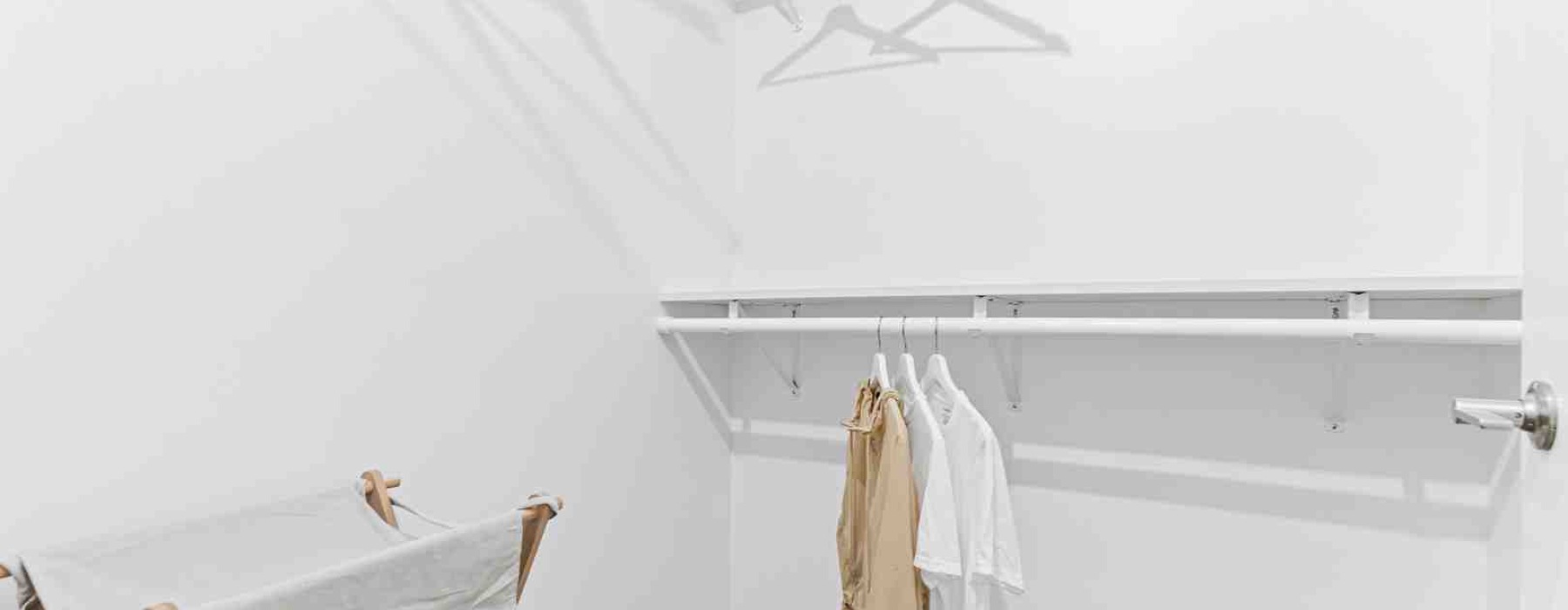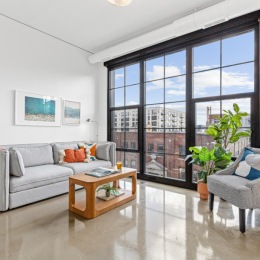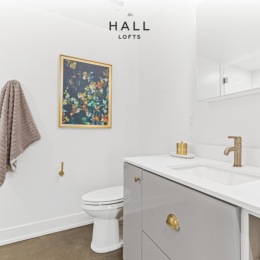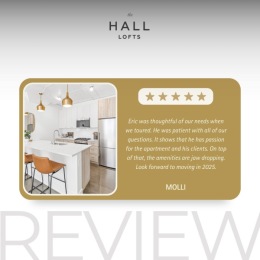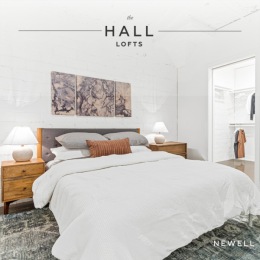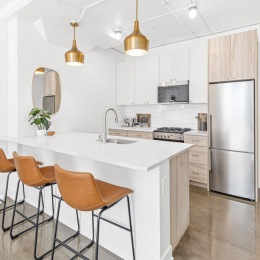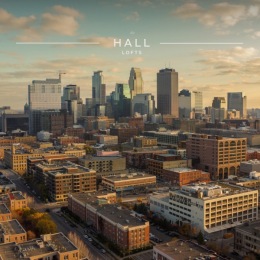Why Historic Lofts Define Minneapolis Urban Living
Historic lofts for rent minneapolis offer a unique blend of 19th-century industrial charm and modern urban conveniences that you simply can't find in traditional apartment buildings. These converted warehouses, factories, and even churches provide distinctive living spaces with soaring ceilings, exposed brick walls, and original hardwood floors.
Top Historic Loft Options in Minneapolis:
• North Loop Warehouse District - Former industrial buildings with 10-14 foot ceilings
• Mill District - Converted flour mills near the Mississippi River
• Uptown - Repurposed church buildings with stained glass windows
• Prospect Park - Affordable warehouse conversions with modern amenities
Most historic lofts in Minneapolis feature exposed brick walls, timber beams, and oversized windows that flood spaces with natural light. One-bedroom units typically range from 850-1,077 square feet, while two and three-bedroom lofts can span up to 2,200 square feet.
The city's warehouse district and riverfront areas house the most authentic historic buildings. Many date back to the 1880s-1920s when Minneapolis was a major milling and manufacturing hub. Today, these spaces combine original architectural details with modern necessities like in-unit laundry, fitness centers, and high-speed internet.
"These beautiful lofts are bursting with historic charm and rich character," as one property manager describes the appeal of warehouse-to-residential conversions.
Unlike cookie-cutter apartment complexes, each historic loft offers unique layouts and character that reflect the building's original industrial purpose. You'll find everything from former candy factories to textile mills transformed into distinctive living spaces.
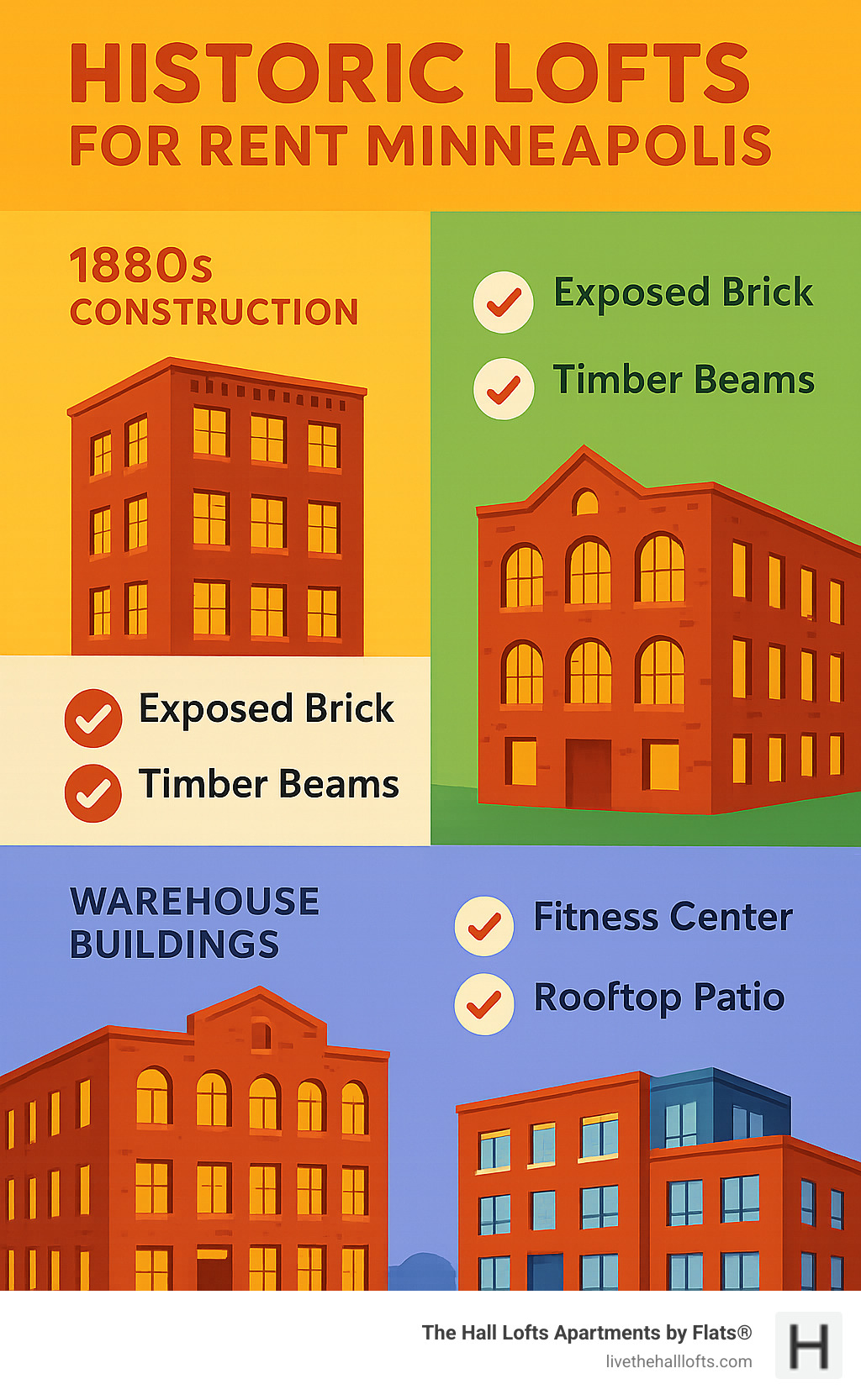
What Makes a Loft Historic?
When you step into a true historic lofts for rent minneapolis, you're walking into a piece of the city's industrial past. These aren't just apartments with exposed brick thrown up for style – they're authentic buildings with real stories to tell.
Most historic lofts earn their title by being listed on the National Historic Register or dating back to Minneapolis's industrial golden age between 1880 and 1920. During this era, the city was a manufacturing powerhouse, and these massive warehouse and factory buildings were the backbone of that economy.
The telltale signs of authenticity are hard to miss once you know what to look for. Those exposed brick walls aren't decorative – they're the original load-bearing walls that held up heavy machinery. The timber beams overhead are often made from old-growth wood that's simply impossible to find today. And those soaring 10 to 14-foot ceilings? They were designed to accommodate industrial equipment and provide proper ventilation for workers.
Industrial-sized windows are another dead giveaway. These floor-to-ceiling beauties weren't installed for Instagram photos (though they certainly don't hurt). Factory owners needed maximum natural light to keep their workers productive during long shifts. Today, these same windows flood your living space with gorgeous natural light throughout the day.
The original hardwood floors beneath your feet have stories to tell too. Made from old-growth timber, they've withstood decades of heavy machinery and foot traffic. After proper restoration, they provide a durability and character that modern materials simply can't replicate.
Living in a converted candy factory or textile mill connects you to Minneapolis's change from industrial powerhouse to modern urban center. It's like having a piece of the city's DNA built right into your walls.
More info about Renovated Loft Apartments
Historic vs. Conventional Apartments
The difference between historic lofts and conventional apartments goes way deeper than just looks. When you choose a historic loft, you're choosing heritage materials that tell a story – exposed brick that's weathered decades, steel beams that once supported heavy machinery, and hardwood that's gained character with age.
Open-concept layouts in historic lofts aren't a design trend – they're a natural result of industrial origins. These spaces were built for manufacturing, which means large, unobstructed areas that give you incredible flexibility for arranging your furniture and creating distinct living zones.
The noise transfer situation is interesting in historic buildings. Those thick brick walls between units act like natural sound barriers, so you're less likely to hear your neighbors through the walls. However, those high ceilings can make sounds bounce around more within your own space – something to keep in mind if you're planning late-night dance parties.
Utility costs in historic buildings depend heavily on how well the renovation was handled. Original single-pane windows might look amazing, but they can make your heating bill spike during Minnesota's brutal winters. The good news is that most well-renovated historic lofts now feature energy-efficient upgrades that balance character preservation with comfort.
Modern building codes ensure that historic renovations meet contemporary safety standards. This means you get sprinkler systems, updated electrical wiring, and accessible features alongside all that vintage charm. It's the best of both worlds – 19th-century character with 21st-century safety and convenience.
| Feature | Historic Loft | Modern Apartment |
|---|---|---|
| Ceiling Height | 10-14 feet | 8-9 feet |
| Wall Material | Exposed brick/original plaster | Drywall |
| Floor Plan | Open, flexible layouts | Defined room separation |
| Windows | Large, industrial-style | Standard residential |
| Character Features | Timber beams, iron columns | Minimal architectural details |
| Sound Insulation | Thick brick walls between units | Standard insulation |
Historic Lofts for Rent Minneapolis – Neighborhood Hotspots
Minneapolis spreads its historic lofts for rent minneapolis across several vibrant neighborhoods, each telling its own story of the city's industrial past. These warehouse districts and mill corridors have transformed from manufacturing hubs into some of the most sought-after residential areas in the Twin Cities.
The warehouse district and North Loop anchor Minneapolis's historic loft scene. Here, 19th-century industrial buildings line tree-covered streets where freight trains once rumbled. Today, these same streets buzz with bike lanes, brewpubs, and boutique retail shops. The area's proximity to Target Field and the Mississippi River trails makes it perfect for residents who want both urban energy and outdoor recreation.
The Mill District showcases a different side of Minneapolis history. Massive stone mills and grain elevators that once powered the city's flour industry now house unique residential spaces. This riverfront corridor offers stunning water views and direct access to riverside parks, plus easy light-rail connections to downtown and beyond.
Prospect Park provides a more affordable entry point into historic loft living. The converted warehouses here maintain authentic industrial character while offering modern amenities at lower price points than downtown locations. The neighborhood combines vintage charm with convenient highway access.
Uptown surprises visitors with its church conversions and institutional building changes. These adaptive reuse projects preserve architectural treasures like stained glass windows and vaulted ceilings while creating truly distinctive living spaces.
Transit access varies throughout these neighborhoods, with walkability scores consistently high across all historic loft areas. Most residents find they can easily reach restaurants, parks, and entertainment venues on foot or by bike.
More info about North Loop Apartments
North Loop Warehouse District (historic lofts for rent minneapolis)
The North Loop reigns as Minneapolis's warehouse living capital. This revitalized district packs the city's best collection of historic lofts for rent minneapolis into walkable blocks where importing companies and candy manufacturers once operated.
The neighborhood pulses with energy day and night. Brewpubs pour local craft beer while boutique retail shops offer everything from vintage clothing to handmade furniture. When baseball season arrives, Target Field fills the streets with fans heading to and from games. Well-designed bike lanes make cycling safe and fun throughout the area.
These North Loop buildings showcase authentic warehouse DNA. Former loading docks now serve as dramatic residential lobbies, while old freight elevators carry residents to their homes. Massive timber support beams create stunning focal points in living spaces, and wide streets originally designed for freight traffic now accommodate food trucks and sidewalk dining.
The area's walkability makes owning a car optional rather than essential. Downtown Minneapolis sits just blocks away, while the Mississippi River provides scenic walking paths and recreational opportunities. This combination of urban convenience and historic character attracts young professionals and those seeking vibrant city living.
Mill & Riverfront Corridor (historic lofts for rent minneapolis)
The Mill District tells Minneapolis's flour milling story through converted stone mills and grain elevators that now house residential lofts. These massive structures were built to handle enormous weight and machinery, resulting in incredibly thick walls and fascinating architectural details.
Riverside parks provide immediate access to walking and biking trails that follow the Mississippi River's curves. The Guthrie Theater and other cultural attractions make this area particularly appealing to arts lovers. Light-rail connections simplify trips to downtown Minneapolis, the airport, and other Twin Cities destinations.
Stone mill conversions offer different character than their brick warehouse cousins. The buildings' original milling purpose required unique architectural solutions, creating floor plans you won't find anywhere else. Some units feature curved walls that follow original grain silos, while others showcase massive stone foundations and industrial-sized windows that flood spaces with natural light.
The riverfront location delivers both scenic beauty and recreational opportunities. Residents can kayak on the water, bike along riverside trails, or simply enjoy morning coffee while watching the river flow past their windows. This blend of natural beauty and historic architecture creates a living environment that feels both urban and peaceful.
Scientific research on walkability
Notable Buildings & Floor Plan Variety
Minneapolis's historic loft buildings showcase remarkable diversity in both architectural heritage and modern floor plan options. Each building tells a unique story through its conversion from industrial or institutional use to residential living.
The variety of original building types creates distinctive living experiences. Former candy factories feature different layouts than textile mills, while converted churches offer soaring spaces with unique architectural details. One-bedroom units typically range from 850 to 1,077 square feet, providing generous living space compared to conventional apartments.
Two and three-bedroom lofts can span up to 2,200 square feet, often featuring multiple levels or unique layouts that follow the building's original configuration. Studios offer affordable entry points into historic loft living, while one-bedroom plus den configurations provide flexibility for home offices or guest spaces.
Many buildings offer skyline views from upper floors, taking advantage of their industrial heritage and strategic locations. Original windows, often oversized for factory lighting needs, frame dramatic cityscapes and provide abundant natural light throughout the day.
The adaptive reuse of these buildings preserves Minneapolis's architectural heritage while meeting modern housing needs. Each conversion project balances historic preservation with contemporary comfort, resulting in unique living spaces that cannot be replicated in new construction.
Exposed-Brick Classics
The most sought-after historic lofts feature authentic exposed brick walls that showcase the craftsmanship of 19th-century builders. These brick surfaces, originally designed for industrial durability, now provide textural interest and thermal mass that helps regulate indoor temperatures.
Ceilings soaring 10 to 14 feet create dramatic vertical space that makes even smaller units feel expansive. Original hardwood floors, typically made from old-growth timber, provide warmth and character that modern materials cannot match. Iron columns and steel beams, left exposed during renovation, serve as striking architectural features while supporting the building's structure.
Modern amenities seamlessly integrate into these historic shells. In-unit laundry facilities hide behind custom cabinetry, while updated kitchens feature contemporary appliances against backdrop of original brick walls. Large windows, originally designed for factory lighting, now frame city views and flood living spaces with natural light.
The combination of authentic materials and modern systems creates living spaces that honor the building's heritage while providing contemporary comfort. These units often feature unique layouts that follow the building's original configuration, resulting in spaces that feel both historic and thoroughly modern.
More info about Loft Apartments for Rent
Adaptive-Reuse Standouts
Some of Minneapolis's most distinctive lofts come from unexpected building conversions that showcase creative adaptive reuse. The Spanish Mission Style church conversion preserves stained glass windows, crystal chandeliers, and soaring ceilings while creating unique residential spaces that honor the building's spiritual heritage.
The former Gurley Candy Company building, originally opened in 1920, demonstrates how industrial buildings can be transformed into luxury living spaces. This conversion preserves the building's commercial character while adding modern amenities like fitness centers and rooftop patios.
Workforce housing warehouse conversions show how historic preservation can address contemporary affordability needs. These projects maintain authentic architectural details while providing accessible housing options in desirable neighborhoods.
Campus-style developments combine multiple historic buildings to create comprehensive communities. These projects offer residents access to amenities across several buildings, creating the feel of a unified neighborhood within the larger urban context. Rooftop patios and shared community spaces foster social connections while preserving each building's individual character.
Price, Amenities & Pet Policies Snapshot
When considering historic lofts for rent minneapolis, you'll find that these unique spaces offer excellent value for their distinctive character and prime locations. One-bedroom units typically provide generous living space ranging from 850 to 1,077 square feet, while two-bedroom lofts often exceed 1,400 square feet with layouts that feel even more spacious thanks to those soaring ceilings.
The premium you'll pay for historic character - usually around 10-15% above comparable modern apartments - comes with benefits you simply can't find elsewhere. You're not just renting an apartment; you're becoming part of Minneapolis's architectural heritage while enjoying some of the best urban locations the city has to offer.
Parking and pet policies make historic loft living surprisingly practical. Garage spaces, which are definitely worth considering during those Minnesota winters, typically add extra monthly costs but provide heated protection for your vehicle. Many buildings offer both garage and surface parking options to fit different budgets.
Pet lovers will appreciate that most historic loft buildings welcome furry companions with reasonable deposit requirements and often no monthly pet fees. This pet-friendly approach reflects the community-minded culture that tends to develop in these unique buildings.
Modern amenities blend seamlessly into historic settings, creating the best of both worlds. Fitness centers, rooftop grills, and co-working spaces have become standard features that help justify the investment while building connections among residents. Package receiving, on-site management, and responsive maintenance services ensure that daily life runs smoothly despite the buildings' historic nature.
Some buildings include workforce housing components that provide opportunities for moderate-income residents to experience historic loft living in prime locations. These income-restricted options help maintain economic diversity in desirable neighborhoods.
Latest research on school proximity
Pros & Cons Checklist
Living in historic lofts for rent minneapolis comes with a unique set of advantages and considerations that differ significantly from conventional apartment living. Understanding these factors helps ensure that historic loft living matches your lifestyle and expectations.
The natural light in historic lofts is simply spectacular. Those oversized industrial windows flood your space with brightness that makes even cloudy Minneapolis days feel cheerful. The unique layouts mean your home won't look like anyone else's - you'll have conversation-starting architectural details like exposed brick walls and massive timber beams that create instant character.
High ceilings transform the entire feel of your living space, making even smaller units feel expansive and airy. The prime urban locations put you within walking distance of the city's best restaurants, entertainment, and the beautiful Mississippi River trails. There's also something special about the community culture that develops among residents who share an appreciation for historic architecture and urban living.
However, historic living does come with some trade-offs. Limited closet space reflects these buildings' industrial origins - they weren't designed with modern storage needs in mind. You might experience potential drafts around original windows, especially during harsh Minnesota winters, though many buildings have upgraded to energy-efficient alternatives.
Maintenance timelines can be longer in historic buildings, where repairs often require specialized knowledge and materials. The open-concept layouts that make these spaces feel so spacious can also mean noise transfers more easily between living areas within your unit.
The community culture that develops in historic buildings tends to be strong and welcoming. Residents often share a genuine appreciation for architectural heritage and urban living, creating lasting friendships and a real sense of neighborhood within the building. Well-managed historic properties typically provide excellent service, making the unique aspects of historic living feel like advantages rather than challenges.
More info about Modern Urban Apartments
How to Secure Your Historic Loft
The application process for historic lofts for rent minneapolis follows standard rental procedures with some unique considerations. Most buildings require income verification showing earnings at least three times the monthly rent, along with credit checks and background screening.
Application fees typically range from $50 to $100 per adult applicant. Security deposits usually equal one month's rent, though some buildings offer reduced deposits for applicants with excellent credit. Pet deposits add approximately $250 for buildings that welcome furry residents.
Many historic loft buildings now offer online application portals that streamline the process. Virtual Matterport tours allow prospective residents to explore units remotely, particularly helpful when touring multiple buildings or relocating from another city.
Timing matters in the competitive historic loft market. Spring and summer see the highest demand, while fall and winter may offer better selection and negotiating power. Having all documentation ready speeds the application process when you find the perfect unit.
Some buildings offer income-restricted units that provide affordable access to historic loft living. These programs typically require income verification and may have waiting lists, but they create opportunities for moderate-income residents to enjoy prime urban locations.
More info about Converted Warehouse Apartments
Quick-Start Rental Checklist
Preparing your application materials in advance helps you move quickly when you find the right historic loft. Having these documents ready can make the difference in competitive rental markets.
Essential Documentation:
- Recent pay stubs or employment verification letter
- Bank statements showing savings and checking account balances
- Photo identification (driver's license or passport)
- Previous landlord references and contact information
- Pet vaccination records and photos (if applicable)
- Renters insurance quote or existing policy information
Financial Preparation:
- First month's rent
- Security deposit (typically one month's rent)
- Pet deposit if applicable
- Application fees for each adult applicant
- Utility setup deposits
Practical Considerations:
- Schedule tours during different times of day to assess lighting and noise
- Research parking options and costs in the neighborhood
- Verify internet and cell phone coverage in the building
- Ask about utility costs and what's included in rent
- Understand the building's pet policy and any breed restrictions
Being prepared to move quickly while maintaining thorough evaluation helps you secure the best historic loft for your needs and budget.
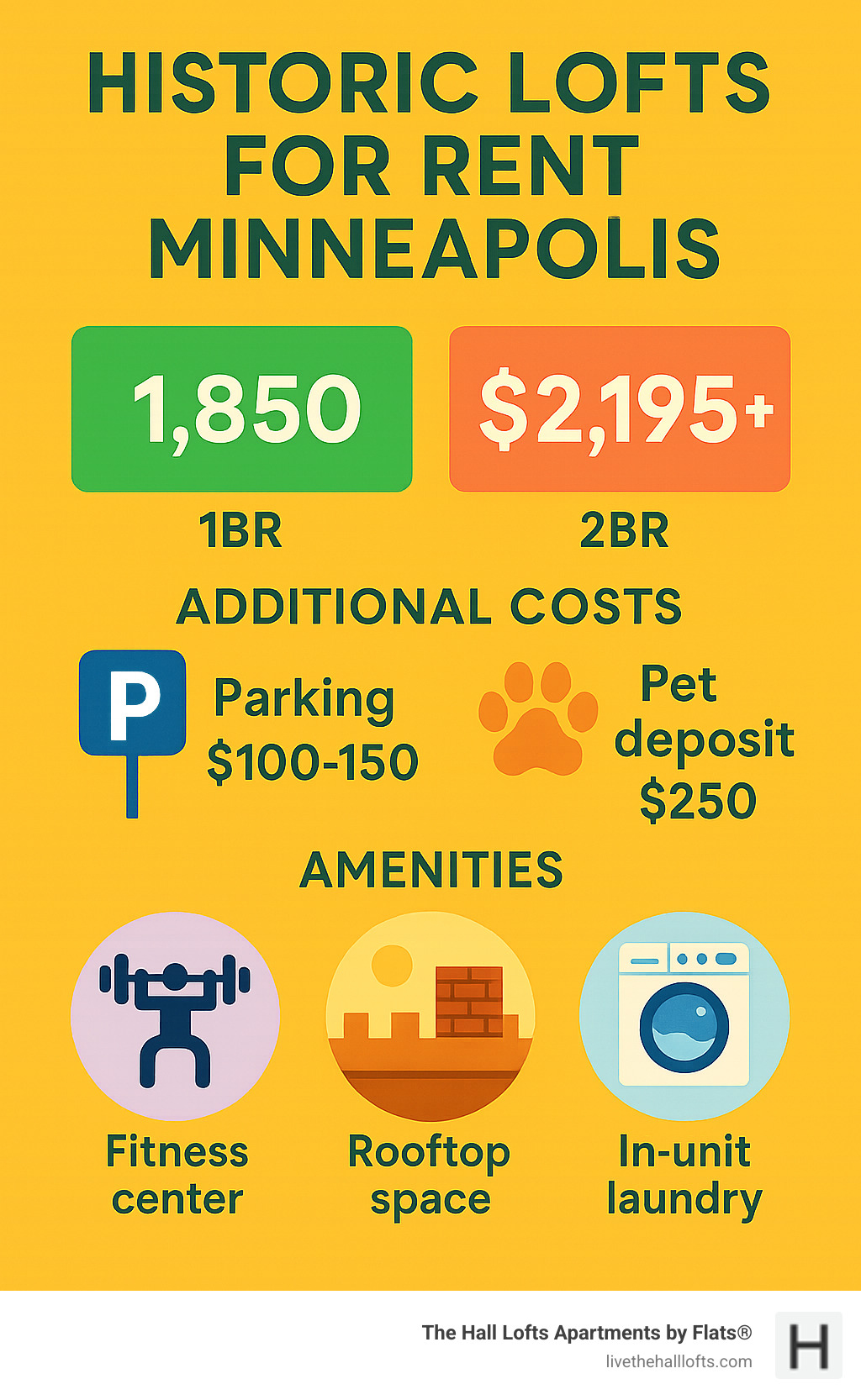
Frequently Asked Questions about Historic Loft Living in Minneapolis
What floor plans are most common?
Historic lofts for rent minneapolis typically feature one-bedroom layouts as the most popular option, usually spanning 850 to 1,077 square feet. These units showcase the beauty of open-concept living, where soaring ceilings and massive windows create an airy atmosphere that feels much larger than the actual square footage.
The charm of historic loft floor plans lies in their flexibility and uniqueness. Unlike cookie-cutter apartments, each unit reflects the building's original purpose. You might find a former candy factory with gently curved walls following the old production flow, or a converted mill with split-level areas that once housed different manufacturing processes.
Two-bedroom lofts offer generous space, often exceeding 1,400 square feet, while three-bedroom units can reach up to 2,200 square feet. These larger layouts frequently feature interesting configurations like loft bedrooms accessed by spiral staircases or sleeping areas tucked into former storage alcoves.
For those just starting their loft journey, studios provide an affordable entry point into historic living. Many buildings also offer one-bedroom plus den configurations, perfect for creating a home office or accommodating overnight guests in your own slice of Minneapolis history.
Are historic lofts pet-friendly?
You'll be happy to know that most historic lofts for rent minneapolis roll out the welcome mat for your furry family members. The majority of buildings accept both cats and dogs, typically allowing up to two pets per apartment. Each building has its own personality when it comes to breed restrictions, so it's worth checking the specific policies.
The financial aspect is refreshingly straightforward. Pet deposits usually run around $250 with no ongoing monthly fees, making historic loft living surprisingly budget-friendly for pet parents. This one-time cost often includes coverage for any potential damages, giving both you and your landlord peace of mind.
North Loop's walkability makes it a dog paradise, with numerous parks and the scenic Mississippi River trails just steps away. Many historic buildings have acceptd pet-friendly amenities like enclosed dog runs, nearby green spaces, and even pet washing stations for those muddy paw situations.
Some converted church buildings or smaller historic properties might have tighter pet policies due to space considerations or unique building regulations. The key is asking upfront about pet policies before you fall in love with a particular loft.
How do rents compare to new luxury apartments?
Historic lofts typically carry a premium of about 10-15% over comparable modern apartments, but here's the thing – you're getting so much more than just a place to live. You're investing in authentic architectural character that simply cannot be recreated in new construction.
When you consider what that premium buys, the value becomes clear. Exposed brick walls, original hardwood floors, and 12-foot ceilings are features that modern developers can only dream of replicating. Historic lofts often provide more square footage than similarly priced new apartments, plus you're living in neighborhoods with established character and proven long-term appeal.
The location advantage adds significant value to the equation. Historic loft neighborhoods offer superior walkability, established dining scenes, and cultural attractions that have been drawing residents for decades. You're not gambling on whether a new development will create community – you're moving into areas where vibrant neighborhoods already exist.
For many residents, the slight premium pays dividends in daily satisfaction. There's something special about coming home to a space with genuine history, where every exposed beam and brick wall tells part of Minneapolis's industrial story. That's not something you can put a price tag on.
Conclusion
Finding the perfect place to call home in Minneapolis becomes an trip when you explore historic lofts for rent minneapolis. These remarkable spaces offer something truly special - the chance to live within walls that have witnessed over a century of the city's evolution, from busy industrial hub to vibrant modern metropolis.
The magic happens in the details. Those exposed brick walls aren't just decorative elements - they're storytellers that connect you to Minneapolis's rich manufacturing heritage. The soaring ceilings and massive windows that once illuminated factory floors now frame stunning city views and flood your living space with natural light that changes throughout the day.
The Hall Lofts Apartments by Flats® understands this unique appeal perfectly. We've taken the industrial bones of historic warehouse buildings and thoughtfully woven in everything modern life demands. You get the authentic character of original timber beams and brick walls alongside conveniences like in-unit laundry and contemporary kitchens that make daily life effortless.
What makes historic loft living truly rewarding goes beyond the architectural features. It's about joining a community of people who appreciate authenticity and urban energy. Your neighbors likely chose loft living for the same reasons you did - they value character over cookie-cutter design and accept the vibrant culture that comes with downtown living.
The journey to secure your historic loft might require some patience and preparation, but the payoff is worth every step. Whether you're drawn to a converted candy factory with quirky layouts or a former textile mill with riverside views, these spaces offer living experiences you simply cannot find anywhere else.
Ready to find what historic loft living feels like? We'd love to show you around and help you envision your life in one of these extraordinary spaces. The blend of history and modern comfort is waiting for you to experience it firsthand.

